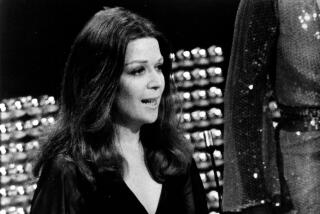A Pregnant Episode in TV History
- Share via
Imagine if Mary Richards, the character played by Mary Tyler Moore in her classic sitcom, had become pregnant.
Imagine the public uproar. Mary Richards, America’s TV sweetheart and symbol of independent, single women in the ‘70s, would have been all washed up. “The Mary Tyler Moore Show” would have been dead.
But it’s now the ‘90s. And in the season finale of the show most compared to Moore’s, “Murphy Brown,” the title character--an independent, single woman played by Candice Bergen--discovers that she is pregnant.
So what happened?
The episode finished No. 1 for CBS in the national ratings released this week.
More significant, there wasn’t even a ripple of big-time controversy when the pregnancy episode aired May 20.
Like Mary Richards, Murphy Brown works in a TV newsroom--and, to many viewers, is America’s new sweetheart of the home screen.
Thus, viewer phone-in response--pro or con--might have been expected after the surprise plot development. But CBS says there was none to speak of at the network’s Los Angeles headquarters.
It’s no secret that TV has changed drastically in recent years in dealing with such matters as sex and frank language.
But something even more important has changed: us.
And it’s a providential TV coincidence that, on the heels of Murphy Brown’s pregnancy, CBS on Sunday will begin six prime-time reruns of the show that probably changed us more than any other, “All in the Family,” which broke more taboos on subject matter than any other series.
To get an idea of just how revolutionary “All in the Family” was, consider the fact that it debuted only four months after “The Mary Tyler Moore Show”--yet seemed from another planet, with its lasting influence arguably extending right up to last week’s “Murphy Brown” pregnancy episode.
Mary Richards’ eternal and beguiling innocence was epitomized by one of her most memorable pieces of dialogue: “I’m an experienced woman. I’ve been around. . . . Well, all right, I might not’ve been around, but I’ve been . . . nearby.”
“Murphy Brown,” on the other hand, will have to deal next season with whether its lead character keeps her baby, as well as with the identity of the father and whether she marries him.
It is, in short, a notable rite-of-passage for TV. For while pregnancies of single women have become common occurrences in story lines, it is not too often that they happen to the lead character of a lighthearted series that seeks grass-roots approval.
Although the title character in “The Days and Nights of Molly Dodd”--a single woman--recently became pregnant and had a baby, the show is on cable TV, which generally takes more liberties, is less mainstream than networks and draws a small audience by comparison.
And the memory of ABC’s successful “Moonlighting” series, which fell apart just a few seasons ago after the central character played by Cybill Shepherd became pregnant, may well have been on CBS’ mind.
“The Mary Tyler Moore Show” isn’t ancient--it debuted in 1970 and ended only 14 years ago, in ’77. Yet the creators were even forced to discard their original notion of making Mary Richards a divorced woman. It wasn’t acceptable to CBS.
And, in fact, CBS was still very careful about its handling of Murphy Brown’s pregnancy, even now. There was no big fuss in the promotion of the episode. This could have been a touch of simple sophistication toward contemporary TV audiences. It could also have been ongoing sensitivity toward disapproving viewers. Maybe both.
In any case, the strategy certainly worked--at least thus far, before the season-ending cliffhanger is forced to resolve itself when “Murphy Brown” resumes in the fall.
CBS’ handling of the final episode “was deliberate on our part,” says a network official, adding that the idea was to emphasize Murphy’s relationships with the men in her life rather than the sequence in which she discovered she was pregnant.
And then there was the confusion factor among many viewers over the episode’s depiction of that final sequence, network officials acknowledge.
“Some men, and even some women, didn’t know what a home pregnancy test looks like,” said the CBS spokeswoman. “Some people were confused.”
What is most pertinent, however, is a network’s assessment of its audience before it takes the kind of step it took with “Murphy Brown”--and for this, it is instructive to note some guidelines from CBS’ program standards.
“There is no way to feed a television program into a computer and determine whether it meets appropriate standards for the ‘typical television viewer,’ ” says the introduction to the standards. “Indeed, there is no ‘typical viewer.’ . . . Every viewer brings a slightly different perspective to each program.”
Even more to the point, the guidelines add: “The ultimate principle to which we subscribe is that the viewer and society at large set the standards of acceptability. As cultural and social views change over time, we must be prepared to respond.”
In short, all bets are off if viewers accept Murphy Brown’s pregnancy--and the No. 1 rating indicates that they will, unless the resolution is botched. While CBS says the pregnancy won’t become the focus of the show, the network nonetheless is taking a bit of a risk with its high-flying, trademark series.
It’s worth it, of course. Story lines like the “Murphy Brown” cliffhanger are kid stuff for films and the theater. And CBS, which moved over the years from Lucy and “The Honeymooners” to “All in the Family” and “MASH,” now must lure traditionally conservative network viewers into taking another step.
There’s a certain wistfulness, though, in contemplating what has to be done to survive in the rough new world of television. Kind of makes you glad that Mary Richards got out while the going was good.
More to Read
The complete guide to home viewing
Get Screen Gab for everything about the TV shows and streaming movies everyone’s talking about.
You may occasionally receive promotional content from the Los Angeles Times.






